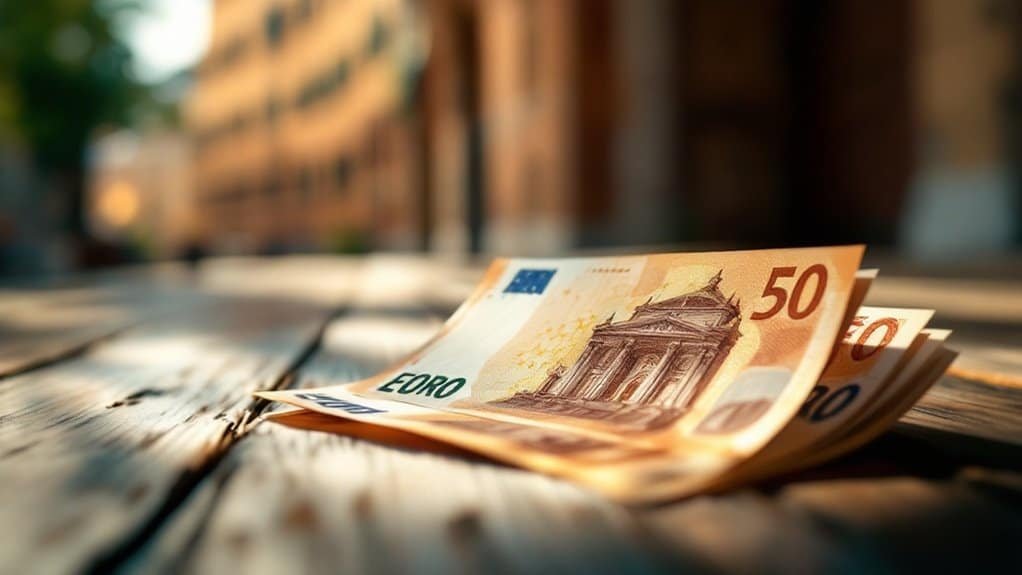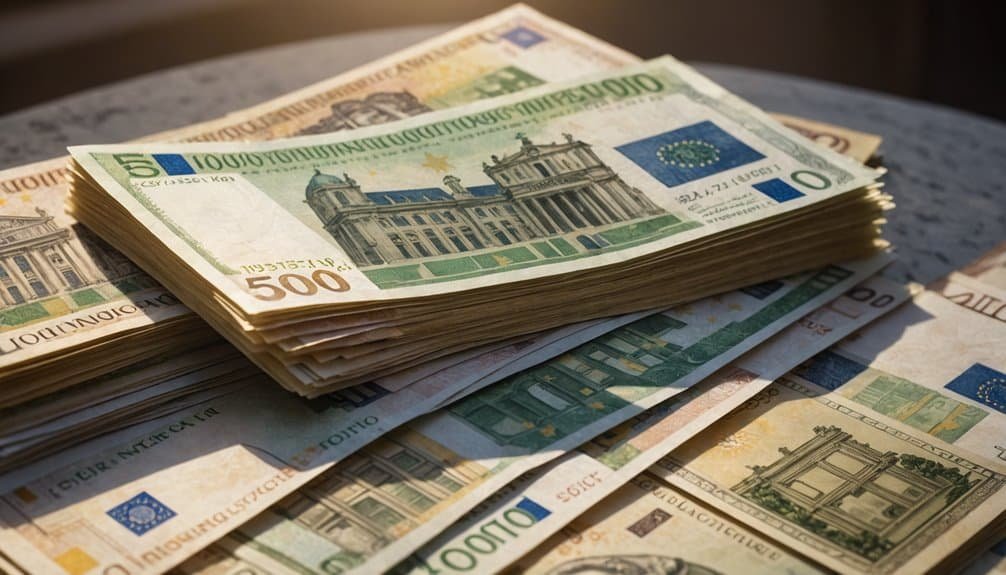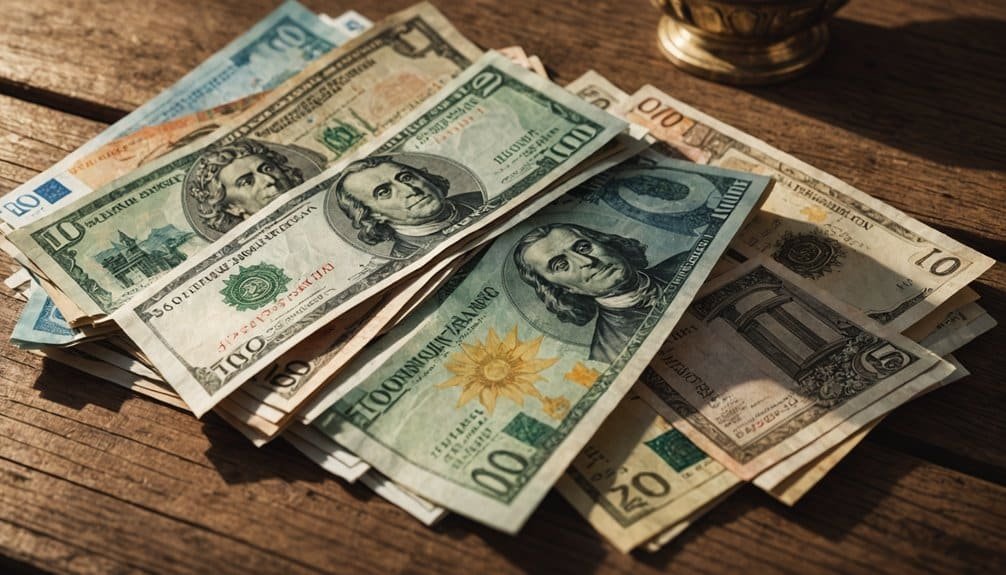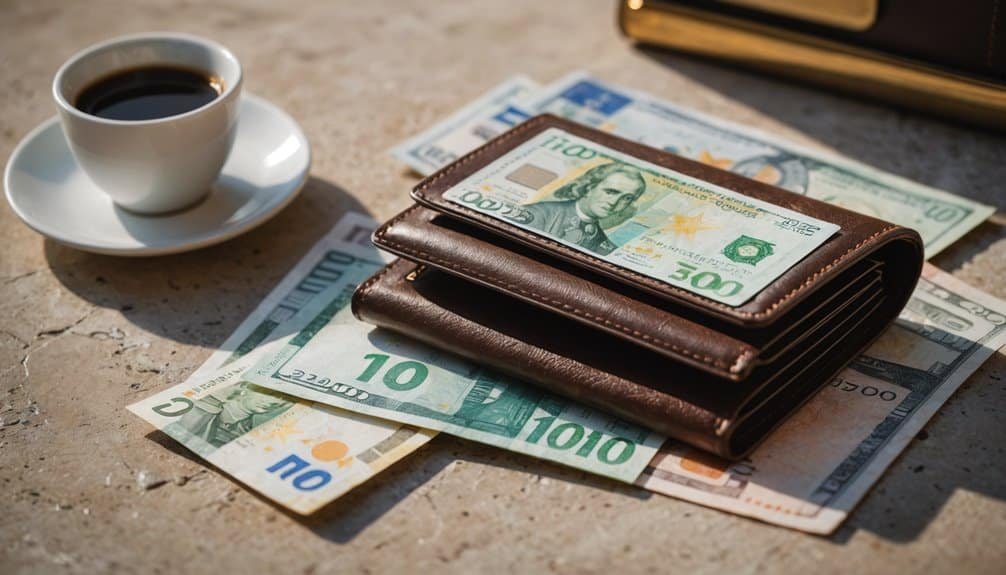
When exploring Florence, you'll want to master using euros smoothly. Cash is king for small purchases, with denominations ranging from €5 to €200 banknotes and 1 cent to €2 coins. ATMs offer convenient withdrawals with minimal fees, and credit cards work well for larger expenses. Exchange shops like Carlo's provide competitive rates, and contactless payments are increasingly common. Tipping isn't mandatory, but a 10% gratuity shows appreciation for exceptional service. Pro tip: travel cards like Wise can help minimize transaction fees and keep your spending in check. Stick around, and you'll reveal more currency savvy secrets for your Italian adventure.
Key Takeaways
- Euro banknotes range from €5 to €200, with unique security features like "feel, look, and tilt" authentication methods for traveler confidence.
- Cash is recommended for small purchases in Florence, with a mix of cash and credit cards providing flexible spending options.
- ATM withdrawals offer convenient access to Euros with minimal fees, and contactless payments are increasingly accepted in transportation and retail settings.
- Currency exchange shops like Carlo's provide competitive rates, while travel debit cards such as Wise help minimize international transaction expenses.
- Tipping isn't mandatory in Italy, but a 10% gratuity is appreciated for exceptional service in restaurants, cafes, and other hospitality venues.
Understanding the Euro
The euro stands as a pivotal financial instrument that transformed economic interactions across Europe. Born from decades of strategic planning, this currency's significance emerged through key milestones like the Treaty of Rome and the Maastricht Treaty, marking a remarkable currency evolution. Monetary policy coordination laid the groundwork for creating a unified economic framework that would eventually enable the euro's implementation.
When you explore the euro's journey, you'll discover it officially launched on January 1, 1999, replacing national currencies and establishing a unified monetary system. The European Central Bank orchestrated this complex shift, setting fixed exchange rates and implementing a single monetary policy across participating countries.
Understanding the euro means recognizing its role beyond national boundaries. It's more than just money—it's a symbol of European economic integration, facilitating seamless transactions and representing a collective financial vision that connects diverse economies into one cohesive monetary landscape.
Banknotes and Coin Basics
Having explored the euro's broader economic significance, let's zoom in on the tangible components that make up this currency: banknotes and coins. Italy's euro denominations offer a fascinating mix of practical design and security features. You'll encounter banknotes ranging from €5 to €200, each with unique security elements like the "feel, look and tilt" authentication method. European Central Bank regulations ensure strict security standards across all euro currency designs.
| Banknote Features | Coin Characteristics |
|---|---|
| Security portrait | 8 metal denominations |
| European design | Standardized map side |
| Anti-counterfeiting tech | National design variation |
Coins are equally intriguing, with eight denominations from 1 cent to €2. While each coin displays Italian icons on one side, they remain valid across the entire eurozone. Whether you're shopping in Florence or traveling elsewhere, understanding these banknote features and coin designs will help you navigate monetary transactions with confidence.
Exchange Rates Explained

While traversing foreign currencies can seem complex, understanding exchange rates is essential for travelers and investors alike. When you're exchanging euros in Italy, you'll encounter dynamic exchange rate mechanisms that determine how much your money is worth.
Currency fluctuations happen constantly, influenced by economic indicators like interest rates, inflation, and market sentiment. The relationship between euros and dollars shifts hourly, affecting how much purchasing power you'll have during your travels. Eurozone economic policies significantly impact the stability and value of the euro in global markets.
For instance, if the euro strengthens against the dollar, your spending capacity might decrease.
Calculating exchange rates is straightforward: simply multiply or divide your amount by the current rate. Before traveling, check the latest rates and understand that small percentage changes can greatly impact your travel budget.
Money Transactions in Florence
Understanding exchange rates sets the stage for smart financial navigation through Florence's vibrant landscape. When managing currency safety and local spending, you'll want to strategically approach money transactions. Currency exchange shops like Carlo's near the Uffizi offer competitive rates with minimal transaction fees. Consider these key methods:
| Payment Type | Recommended Use |
|---|---|
| Cash | Small purchases, markets |
| Credit Cards | Hotels, restaurants, larger expenses |
| ATM Withdrawals | Getting Euros with minimal fees |
| Contactless Payments | Buses, trams, digital transactions |
| Digital Wallets | Modern, convenient payment option |
Major credit cards work well for significant expenses, but always carry some Euros for smaller transactions. Be mindful of foreign transaction fees and seek cards without these charges. Stick to authorized exchange locations like Carlo or Marco's shop near the Uffizi for the best rates. Remember, while tipping isn't mandatory, a 10% gratuity is appreciated for excellent service, ensuring you navigate Florence's financial landscape smoothly and confidently.
Historical Currency Transformation

Florence's monetary landscape tells a fascinating story of transformation, tracing the evolution from fragmented regional currencies to a unified national tender and ultimately to the euro. Currency standardization emerged as a critical process during Italy's unification, reflecting broader national consolidation efforts.
Before unification, you'd have seen different currencies like the Florin in Florence and the Ducato in Venice. The lira, introduced in 1861, symbolized Italy's monetary unity, initially pegged to the gold standard.
Your understanding of lira nostalgia helps appreciate the complex journey. Through world wars, economic challenges, and periods of hyperinflation, the lira remained a resilient symbol of Italian economic identity.
When Italy joined the European Economic Community, the currency evolution accelerated, culminating in the euro's introduction in 1999.
Central Bank Regulatory Insights
You'll want to understand how Italy's central banking system manages exchange rates and monetary policy through the Bank of Italy's intricate procedures.
The Bank operates within the Eurosystem's framework, implementing key regulatory mechanisms that control currency circulation and financial stability. Official gold reserves serve as a critical component of the Bank's strategic financial management, ensuring robust economic stability and monetary policy coordination.
Exchange Rate Governance
Within the intricate landscape of monetary policy, Italy's exchange rate governance reflects its integration into the European Monetary Union (EMU), where market dynamics and strategic central bank interventions shape currency stability.
You'll find that exchange rates float freely, driven by market fluctuations and influenced by the European Central Bank's (ECB) monetary policy instruments. The ECB doesn't directly control exchange rates but manages them through key interest rates, open market operations, and forward guidance.
Its primary goal is maintaining price stability, keeping inflation below but close to 2%. Foreign banks operating in Italy, such as U.S. financial institutions, play a crucial role in supporting international financial transactions and contributing to the overall monetary ecosystem.
As an investor or traveler, you'll appreciate that the euro's international role remains strong, supported by deeper financial markets and strategic initiatives.
The ECB's careful balance of monetary tools guarantees a stable economic environment for Italy and the broader eurozone.
Central Banking Procedures
Although monetary policy might seem complex, the Bank of Italy's central banking procedures are designed to maintain financial stability and economic equilibrium. You'll find their approach thorough, focusing on strategic monetary policy implementation and robust banking supervision. International reserve management plays a crucial role in the Bank of Italy's broader economic strategy, ensuring national fiscal resilience and maintaining monetary equilibrium.
Key central banking procedures include:
- Setting official interest rates through variable rate auctions
- Conducting open market operations via securities repurchase agreements
- Supervising financial institutions and guaranteeing regulatory compliance
- Monitoring interbank market dynamics
- Coordinating with European Central Bank (ECB) authorities
As a critical component of Italy's financial ecosystem, the Bank of Italy meticulously controls short-term interest rates and manages refinancing mechanisms.
Smart Currency Management Tips

For travelers venturing into and around Florence, mastering smart currency management can transform a potentially stressful financial experience into a smooth, cost-effective journey.
Prioritize currency safety by using travel debit cards like Wise or Revolut, which offer digital payments with minimal transaction fees and real-time currency conversion.
Always carry a mix of euros in cash and cards, ensuring you're prepared for various purchasing scenarios. Currency exchange rates fluctuate daily, so monitoring financial markets can help optimize your spending power.
When using ATMs, stick to reputable bank networks and opt to be charged in local currency to avoid unfavorable exchange rates. Inform your bank about international travel and monitor your transactions closely.
Avoid dynamic currency conversion and currency exchanges at airports, as these often include hidden fees.
Instead, leverage online converters to understand mid-market rates and make informed financial decisions during your Florentine adventure.
Conclusion
When in Florence, you'll quickly discover that euros are your financial compass. "Money talks," and in Italy, it speaks loudly through convenient banknotes and coins. Master the local currency nuances, stay aware of exchange rates, and you'll navigate transactions like a savvy traveler. Smart planning means fewer financial surprises, ensuring your Florentine adventure remains smooth and stress-free. Embrace the euro, and enjoy your Italian journey.







Guys, isnt it better to use credit cards instead of carrying euros around? The exchange rates are better and its safer too. Plus, most places in Florence accept cards. Just a thought!
Just read this guide on using Euros in Italy. Anyone else think its odd we dont dive deeper into the historical impact of the Euro on Italys economy? Just saying, context matters.
Perhaps you missed the point, this is a practical guide, not a history lesson.
While the Euro explanation was spot on, dont you think a more in-depth analysis of exchange rates would have been useful?
Interesting read! But, dont you think cryptocurrencies could potentially disrupt the traditional Euro usage in Florence, especially among tourists?
So, does anyone else think using euros in Italy feels more authentic than just sticking to credit cards?
Absolutely, nothing beats the charm of using physical euros, credit cards cant match that authenticity!
Interesting read, but dont you think its vital to mention credit cards and ATMs when discussing currency in Italy?